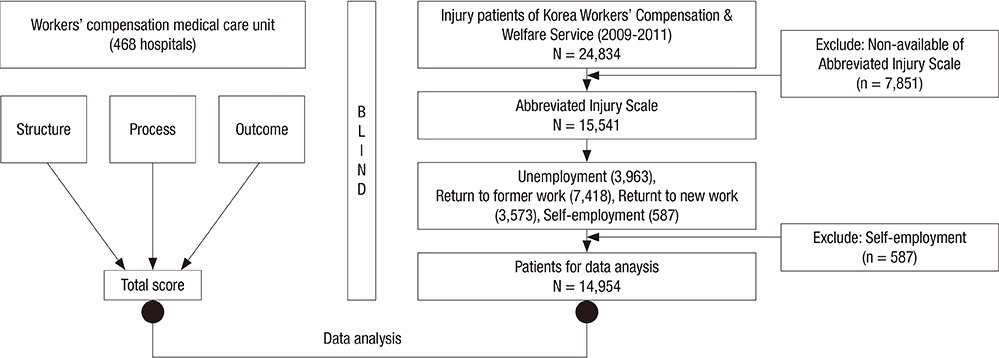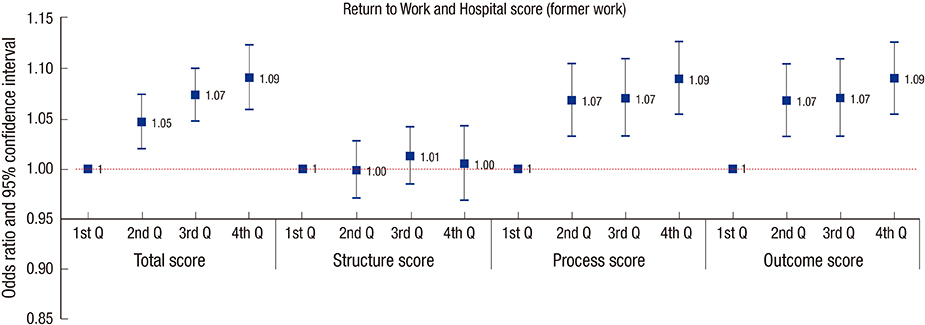J Korean Med Sci.
2016 May;31(5):695-701. 10.3346/jkms.2016.31.5.695.
Hospital Qualities Related to Return to Work from Occupational Injury after Controlling for Injury Severity as Well as Occupational Characteristics
- Affiliations
-
- 1The Institute for Occupational Health, Yonsei University College of Medicine, Seoul, Korea. flyinyou@gmail.com
- 2Department of Preventive Medicine, Yonsei University College of Medicine, Seoul, Korea.
- 3Graduate School of Public Health, Yonsei University College of Medicine, Seoul, Korea.
- 4Department of Occupational and Environmental Medicine, Dankook University College of Medicine, Cheonan, Korea.
- KMID: 2373665
- DOI: http://doi.org/10.3346/jkms.2016.31.5.695
Abstract
- We examined associations between hospital quality in the workers' compensation system and injured patients' return to work after controlling for injury severity, occupational factors, and demographic factors. Return to work data of injured workers were constructed from 2 datasets: 23,392 patients injured in 2009-2011 from the Korea Workers' Compensation & Welfare Service and return to work data from Korea Employment Information Services. After de-identifying the data, quality scores were matched for each hospital that cared for injured patients. Injury severity was measured by Abbreviated Injury Scales. Relative risk and 95% confidence interval were calculated using log binomial regression models. After adjusting for age, sex, injury severity, occupation, factory size, city, and hospital type, the relative risk (95% confidence interval) for the total score was 1.04 (1.02-1.06), 1.06 (1.04-1.09), and 1.07 (1.05-1.10) in the 2nd, 3rd, and 4th quartiles, respectively, compared to the 1st quartile. The RR (95% CI) in the 2nd, 3rd, and 4th quartiles was 1.05 (1.02-1.07), 1.05 (1.02-1.08), and 1.06 (1.04-1.09) for the process score; and 1.02 (1.01-1.04), 1.05 (1.03-1.07), and 1.06 (1.04-1.09) for the outcome score compared to the 1st quartile score, respectively. In conclusion, our study design with blinded merge methods shows that total, process, and outcome qualities are related to the return to work of injured workers after controlling for other factors.
Keyword
MeSH Terms
Figure
Reference
-
1. Dembe AE. The social consequences of occupational injuries and illnesses. Am J Ind Med. 2001; 40:403–417.2. He Y, Hu J, Yu IT, Gu W, Liang Y. Determinants of return to work after occupational injury. J Occup Rehabil. 2010; 20:378–386.3. Park SK. Associations of demographic and injury-related factors with return to work among job-injured workers with disabilities in South Korea. J Rehabil Med. 2012; 44:473–476.4. Rhie J, Jeong I, Won JU. Return-to-work according to impairment type among occupationally injured workers in Korea. J Korean Med Sci. 2013; 28:1581–1586.5. Franche RL, Baril R, Shaw W, Nicholas M, Loisel P. Workplace-based return-to-work interventions: optimizing the role of stakeholders in implementation and research. J Occup Rehabil. 2005; 15:525–542.6. Franche RL, Krause N. Readiness for return to work following injury or illness: conceptualizing the interpersonal impact of health care, workplace, and insurance factors. J Occup Rehabil. 2002; 12:233–256.7. Franche RL, Cullen K, Clarke J, Irvin E, Sinclair S, Frank J. Institute for Work & Health (IWH) Workplace-Based RTW Intervention Literature Review Research Team. Workplace-based return-to-work interventions: a systematic review of the quantitative literature. J Occup Rehabil. 2005; 15:607–631.8. Shaw WS, Pransky G, Fitzgerald TE. Early prognosis for low back disability: intervention strategies for health care providers. Disabil Rehabil. 2001; 23:815–828.9. Himmelstein JS, Pransky G. Measuring and Improving the Quality of Workers' Compensation Medical Care. Princeton, NJ: John Burton's Workers' Compensation Monitor;1995. p. 4–9.10. Won J. Investigation to Develop the Assessment Tool for Workers' Compensation Medical Care System Focus on Rehabiltation, and Its Quantity Score of Hospital. Seoul: Korea Workers' Compensation and Welfare Service;2012.11. Thompson ML, Myers JE, Kriebel D. Prevalence odds ratio or prevalence ratio in the analysis of cross sectional data: what is to be done? Occup Environ Med. 1998; 55:272–277.12. Berecki-Gisolf J, Clay FJ, Collie A, McClure RJ. The impact of aging on work disability and return to work: insights from workers’ compensation claim records. J Occup Environ Med. 2012; 54:318–327.13. Stoddard S, Jans L, Ripple JM, Kraus L. Chartbook on Work and Disability in the United States, 1998. Washington, D.C.: National Institute on Disability and Rehabilitation Research;1998.14. Pransky G, Shaw W, Franche RL, Clarke A. Disability prevention and communication among workers, physicians, employers, and insurers--current models and opportunities for improvement. Disabil Rehabil. 2004; 26:625–634.15. Shaw WS, Feuerstein M, Lincoln AE, Miller VI, Wood PM. Case management services for work related upper extremity disorders. Integrating workplace accommodation and problem solving. AAOHN J. 2001; 49:378–389.16. Kunkel S, Rosenqvist U, Westerling R. The structure of quality systems is important to the process and outcome, an empirical study of 386 hospital departments in Sweden. BMC Health Serv Res. 2007; 7:104.17. Ministry of Employment and Labor (KR). Industrial Accident Compensation Insurance Act: Article No. 130 (2015.4.21). accessed on 19 November 2015. Available at http://www.law.go.kr/lsInfoP.do?lsiSeq=170483#AJAX.18. Shaw W, Hong QN, Pransky G, Loisel P. A literature review describing the role of return-to-work coordinators in trial programs and interventions designed to prevent workplace disability. J Occup Rehabil. 2008; 18:2–15.19. Won J, Ahn Y, Song J, Koh D, Roh J. Occupational injuries in Korea: a comparison of blue-collar and white-collar workers’ rates and underreporting. J Occup Health. 2007; 49:53–60.
- Full Text Links
- Actions
-
Cited
- CITED
-
- Close
- Share
- Similar articles
-
- Association of work–life balance with occupational injury and work-related musculoskeletal pain among Korean workers
- Estimated Occupational Injury Rate and work Related Factors Based on Data From the Fourth Korea National Health and Nutrition Examination Survey
- Exploring Study Designs for Evaluation of Interventions Aimed to Reduce Occupational Diseases and Injuries
- Predictors of Return to Work and Job Retention after Work-Related Injury or Illness
- Factors Associated with Patients' Willingness of Return-to-Work in Industrial Accident Hospitals





